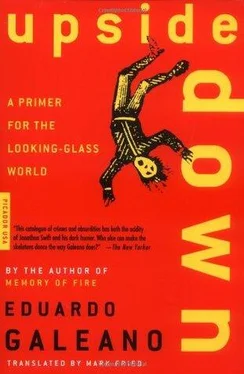A few years later, at the beginning of 1998, the United States tried to repeat this feat. The immense communications apparatus geared up once again to serve the immense military apparatus by convincing the world that Iraq was, again, a threat to humanity. This time, the excuse was chemical and bacteriological weapons. Years before, Hussein had used U.S.-made poison gas against Iran and then had used the same gas to crush the Kurds, and nobody’s hair got the least bit mussed. But panic descended suddenly with the news that Iraq possessed an arsenal of bacteriological weapons: anthrax, bubonic plague, botulism, cancer cells, and other lethal pathogenic agents that any lab in the United States can purchase over the phone or by mail from a company called American Type Culture Collection (ATCC), located just outside Washington. United Nations inspectors, however, found nothing in the palaces of a thousand and one nights, and war was postponed until the next pretext.
The Electronic Friend
The players, absorbed, in a trance, don’t speak to one another.
On the way home from work or to work from home, thirty million Japanese find themselves playing Pachinko and to Pachinko they offer their souls. Players spend hours sitting in front of the machine, shooting little steel balls at needles to win prizes. Every machine is run by a computer that makes sure the players nearly always lose and also that they win once in a while to keep the flame of faith burning. Since gambling for money is illegal in Japan, you play with cards bought with money, and the prizes are paid in gadgets that can be exchanged for money around the corner.
In 1998, the Japanese made offerings of $500 million a day in the temples of Pachinko.

Manipulation of world news by the military isn’t the least bit surprising if you consider the modern history of communications technology. The Pentagon has always been the principal funder of and the principal client for all new developments. The first electronic computer was created to fill a Pentagon purchase order. Communications satellites grew out of military projects, and it was the Pentagon that first set up the Internet to coordinate its operations across the globe. The multimillion-dollar investments made by the armed forces simplified and accelerated the development of communications technology and made it possible to promote their criminal acts worldwide as if they were contributions to world peace.
Fortunately, history is also nourished by paradox. The Pentagon never suspected that the Internet, born to program the world as a great battlefield, would be used to spread the words of pacifist movements usually condemned to near silence. That said, the primary effect of the spectacular development of communications technology and information systems has been to radiate violence as a way of life and as the dominant culture. The communications media, reaching ever more people in more places, accustom us to the inevitability of violence and train us for it from childhood.
On screens — movie, TV, computer — things blow up and bleed ceaselessly. A research project at two universities in Buenos Aires measured the frequency of violence on children’s TV in 1994: one scene every three minutes. The researchers concluded that, by the age of ten, Argentine children have seen eighty-eight thousand acts of violence, not counting the many violent incidents suggested but not portrayed. The dose increases, they found, on weekends. A year before, a poll taken on the outskirts of Lima revealed that nearly every parent condoned that sort of programming: “Those are the programs the kids like.” “That way they’re entertained.” “If they like them, it must be okay.” “It’s better. That way they learn what life is like.” And also, “It doesn’t affect them, it’s nothing.” At the same time, research carried out by the Rio de Janeiro state government concluded that half of all the violent scenes broadcast on the Globo television network were on children’s programs; Brazilian children get brutality shot at them every two minutes and forty-six seconds.
Hours spent in front of the television easily surpass those spent in the classroom, when hours are spent in the classroom at all. It is a universal truth that, with or without school, TV programs are children’s primary source of formation, information, and deformation, as well as their principal source of topics for conversation. The predominance of TV pedagogy is particularly alarming in Latin America in light of the recent decline of public education. In their speeches politicians are prepared to die for education, and in their acts they proceed to kill it, thus liberating children to take more classes in consumption and violence from the small screen. In their speeches politicians denounce the plague of crime and demand an iron hand, and in their acts they encourage the mental colonization of the next generation. From early on, children are trained to find their identities in merchandise that symbolizes power and to get hold of it with a gun.
Do the media reflect reality or shape it? Who begets whom? Is it the chicken or the egg? Wouldn’t a better zoological metaphor be a snake biting its own tail? We give the people what they want, say the media to absolve themselves. But the supply they offer in response to demand creates more demand for more of the same supply; it becomes a habit, creates a need for itself, and turns into an addiction. In the streets there is as much violence as on television, say the media. But violence in the media, which expresses the violence of the world, also promotes more violence.
Europe has had some healthy experiences with the media. In several countries television and radio achieve a high level of quality as public services, run not by the state but directly by organizations that represent diverse sectors of civil society. These experiences, threatened today by a stampede of competition from commercial outlets, offer examples of communication that is truly communicative and democratic, able to speak to people’s human dignity and their right to information and knowledge. But that is not the approach that has been promoted internationally. The world has been slipped a lethal cocktail of blood, Valium, and advertising by private U.S. television networks. They’ve imposed a model based on the proven notion that good is what makes the most profit at the least cost and bad is what pays no dividends.
In Greece at the time of Pericles, there was a tribunal for judging things. It punished the knife, for example, that had been the weapon in a crime, sentencing it to be broken into pieces or thrown into the depths of the sea. Today would it be fair to condemn the television set as the Taliban does? Those who consider TV to have an evil heart slander it by calling it the idiot box. Yes, commercial television reduces communication to business, but obvious though it seems when you say it, TV sets are innocent of the use they are put to and the abuse committed with them. That fact shouldn’t stop us from raising an alarm about what all the evidence makes evident: this, the most worshiped totem of our times, is the medium that has been employed most successfully to impose on the four cardinal points of the earth the idols, myths, and dreams designed by the engineers of emotions and mass-produced by the factories of the soul.
Language/5
Several anthropologists traveled about the countryside on Colombia’s Pacific coast in search of life stories. An old man told them: “Don’t record me, I speak so ugly. Better to get my grandchildren.”
Not far from there, anthropologists traveled about the countryside of Grand Canary Island. Another old man welcomed them, served them coffee, and regaled them with hallucinatory tales delightfully recounted. And then he, too, said: “We speak ugly. They’re the ones who can talk, the kids.”
Читать дальше












